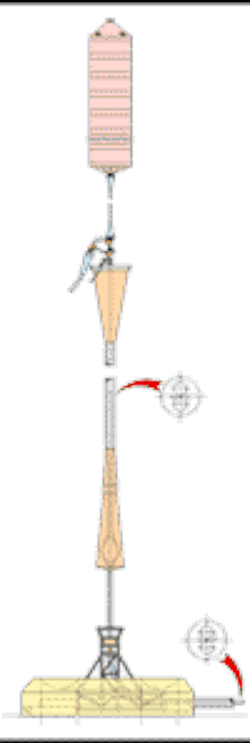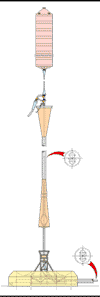FRANCE: Next generation of riser towers for second Angola deepwater project
Kizomba A is the most ambitious develop-ment in progress offshore Angola, based around a tension leg wellhead platform and a 2 MMbbl storage floating produc-tion, storage, and offloading (FPSO) vessel. Under a $230 million contract, Saibos, the joint venture between Bouygues Offshore and Saipem, is responsible for engineering, procure-ment, construction, and installation of most of the subsea facilities. This includes the flowlines, risers, injection lines, umbilical, and the crude offloading system.
Three new designs patented by Bouygues Offshore and Saipem will be deployed. These are:
- Single Line Offset Riser (SLOR) for the water and gas injection line. This will comprise a rigid vertical line connected to the FPSO via a short, flexible jumper. The line will be tensioned vertically by a conventional subsea flotation device and secured on the seabed via a flexible coupling, which allows fluids to pass. The SLOR derives from research from the hybrid riser towers (vertical bundles) installed last year on Girassol
- Kizomba A's production line will incorporate the first use of a pipe-in-pipe SLOR, whereby one pipe positioned inside another creates an annular space that will be filled with Bouygues Offshore's new Vactub insulation medium. This is a rigid foam sealed in a plastic casing under vacuum
- Bundle Riser Tower (BRIT), a riser based on the dual-line bundle technique, offering high-efficiency thermal insulation through a stable kerosene gel or a phase change (liquid/solid) paraffin gel, where temperature performance is claimed to exceed current norms.
The BRIT was described in greater detail in a paper by three Saibos authors at last November's Deep Offshore Technology conference in New Orleans. The design is being targeted particularly at West African deepwater field developments. Beyond 1,500 m, the authors claim, the system's benefits mount due to its low apparent weight. It can also be adapted to an insulation level requiring a U-value of 0.7-3.0 W/m2 degrees K.
Bundle arrangement
BRIT is a vertical bundle, designed thermally in the same way as a flowline bundle. However, a riser bundle needs a cylindrical shape to ensure good hydrodynamic behavior in currents.
The system incorporates two production lines, two gas lift lines, and one carrier pipe. It is fabricated in 100-m sections, each with a specific arrangement at both ends. All sections of the bundle include spacers and two bulkheads, which encapsulate a given quantity of gel.
In each section, the lines are locked together. Differential pipeline expansion is limited as all pipes are maintained at the same temperature, whatever happens during production. This means that one line can be empty and the other can simultaneously handle production without problems. Thermal locking of the lines is effected via a continuous aluminum bridge across all the lines. The whole assembly is secured in position with straps at each spacer, and additionally locked at each bulkhead. There should be no concerns over potential corrosion between the aluminum pad and the steel pipes, as the gel is not an electrolytic fluid. Moreover, the bundle sections are watertight, so water ingress in the gel is not anticipated.
BRIT is designed to be dynamically efficient in mild to severe environmental conditions. Its dynamic and fatigue behavior is similar to that of the SLOR, the authors claim. It can be installed and distributed around a floating support vessel of any size, with or without a turret.
From bottom to top and hang-off, the BRIT comprises the following elements:
- Foundation, including flowline base structure (pipe-in-pipe or bundle)
- Riser porch for a dual, flexible joint or a short tendon with a flexible joint
- Bundle vertical riser
- Top riser table, including goose neck and flexible link attachment points
- Flexible links
- Air can, including piping for coiled tubing intervention
- Flexible jumpers for production, including bend stiffeners at both ends
- Flexible jumpers for gas lift
- Hang-off connectors for flexible jumpers (production and gas lift).
The BRIT is designed to allow a coiled tubing intervention from the top of the air can down to the flowline's first end. To aid this process, Saibos has designed the foundation to facilitate connection of the BRIT and the flowlines via vertical connectors. The flowline or bundle termination assembly (BTA) is fitted with an elbow of 5 m radius to allow acceptable bending and friction for the coiled tubing line. The BTA is then connected and locked to the foundation, which takes the BRIT's vertical loads (100-150 tons).
Saibos modeled the BRIT to evaluate its global motions in addition to stresses under temperature and pressure loads. Fatigue damage in the spool piping above the flex joints also was assessed in order to meet the minimum design life fatigue requirements. The base spool piping was designed to API RP 2RD requirements for risers for floating production systems and tension leg platforms. Analysis was performed using Flexcom-3D software.
According to Saibos, the "floatability" provided by the gel bundle contributes to the design's economics. With a base tension of between 100 and 150 tons, the required buoyancy for the BRIT air can is limited to the equivalent buoyancy of a single SLOR. Depending on the application's water depth, buoyancy is 250 tons (1,000 m) to 350 tons (1,500 m). The air can design is relatively simple, with a weight ratio to net buoyancy of less than 0.3. Savings also accrue through elimination of the bottom spool, as the foundation is designed to cater for future flowline scheme expansion.
The BRIT is fabricated onshore and stored in shallow waters. It can be kept in still water for a long period without risk of corrosion, Saibos claims. For the installation, the BRIT will be manipulated by two anchor handling tugs. The top and bottom parts will be suspended above the seabed in a double catenary configuration. When it has reached a water depth of 500 m, the BRIT is then lowered to its equilibrium towing depth. On arrival, the front tug slows to a halt, with the BRIT eased slowly into a vertical position.
The BRIT is then suspended over the installation vessel's side, with the flexible jumpers connected. Next, the air can is attached to the riser top via the dual flexible link and ballasted to the required level. The BRIT is launched and lowered to a point close to the foundation. A subsea winch fixed on the foundation pulls the BRIT down to the locking points. The system is locked in place, the top adjustable chain system retrieved, and the air can de-ballasted to provide positive buoyancy. Finally, the subsea connectors are connected to the flowline elbows.

